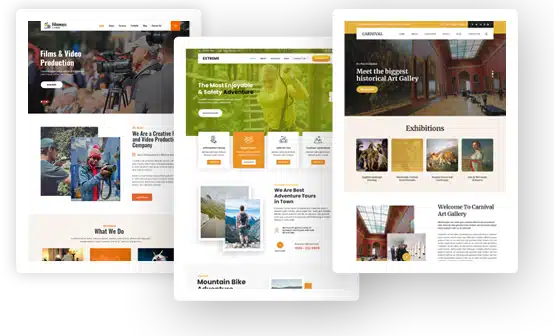Front-End Web Development: What You Need to Know

Web development is a constantly growing field. The way we are building websites today is utterly different from how we used to do it earlier.
In the past decade, it has evolved to a greater extent; the number of options available on the front end is enough to perplex anyone.
The write-up aims to shed light on the importance of front-end development. Additionally, it will also describe the necessary things to consider while developing a website.
But, before moving ahead, let’s explore what exactly is front-end development. So, here we go.
What is Front-end Web Development?
By using Front-end development, data can be converted into a graphical interface by using HTML, CSS, and JavaScript.
In other words, it is a practice that enables the creation of intuitive user experiences for a web application or website. It further helps in defining business success by improving web performance.
One thing which is quite challenging with front end development is the selection of tools and techniques to create the front end of the website.
These are constantly changing, and therefore the developer must be relentlessly aware of how the field is developing.
Tools Used for Front-end Development
There are plenty of tools and platforms available to develop the front end of a website and understanding which tools are best suited for specific tasks.
It is the responsibility of a Front-end developer for implementing designs and concepts on the web.
The core objective behind designing the website is to ensure that when users open the site, they view the information in an accessible and relevant format.
Developers use three primary coding languages to code website and web app design created by web designers:
- HTML
- CSS
- JavaScript
HTML is widely used for laying out content and structuring a document, while CSS is used to style it before JS is implemented, where anything beyond basic interactivity is required.
Often front-end web development is majorly JavaScript-oriented, especially when working on modern, highly-interactive, web applications.
Front-end engineers use massive libraries built on top of these three languages to make development easier.
Whether it is design frameworks like Bootstrap or Foundation, or JavaScript libraries such as AngularJS and React that are proposed to make web development easier.
PHP, Ruby or Python is used to connect data to the back-end. Therefore, familiarity with web-oriented languages other than just the standard HTML, CSS, and JavaScript are also quite important.
What are the Goals and Benefits of Front End Development?
Customers are demanding easy-to-use applications with modern, robust, intuitive features. By combining development, UI, and analytics, organizations can create a seamless experience for customer satisfaction.
Accessibility
With the continued growth of mobile devices, such as smartphones and tablets, designers need to ensure that their site correctly tops browsers on all the tools. Well, this can be accomplished by creating a responsive web design with the help of stylesheets in CSS.
Performance
Performance goals are majorly related to exhibit time, manipulating HTML, CSS and JavaScript to ensure that the website opens in no time.
Slow web pages and applications disappoint visitors looking for alternatives. However, pages with faster loading speeds increase visitor engagement and retention.
Immediate website response will lead to higher conversion rates. Hence, optimized performance is one of the enormous business benefits of front-end development.
Optimize Navigation
Intuitive navigation ensures that visitors get what they want from your site. It includes a structured, clean, streamlined site layout with impressive graphics.
Further, it also helps organizations obtain the business benefits of front-end web development. And this will allow visitors to walk faster. Also, it will be beneficial to gain customer confidence.
Visitor Retention
Well-designed user interfaces inculcate trust and confidence in your brand. Moreover, it helps in achieving your communication goals for higher traffic and conversions.
Also, they can highlight the value for the end-user. This is in contrast to sluggish websites with run-time errors, poor design, and graphics that will reduce usage interest, and further, they will be unlikely to return.
How to get started?
Familiarization of content and media on a website or application helps to target the right customers. Offering a consistent visual language and messaging help relates to products and services. Trademarks and symbols are some essential branding elements.
Listed are some important design considerations. Those goals help trigger positive emotion from customers.
- Use of colour
- Logo insight
- Unique layout
- Use of accurate fonts
Responsive Design
This factors in browser compatibility across platforms. This ensures smooth navigation. However, front-end development tools help to create responsive and fast-loading websites. Besides, it is often seen as a proxy for the success of online businesses.
Benefits of responsive design optimization:
- mproved customer experience
- Better loyalty
- Streamlined buyer journey
- Better visibility with lower cost
Interface Design
The interface design of your website is quite essential for the front end development. Site usability should include smooth communication for users’ purpose.
According to the data, 94% of visitors form an opinion about any web development company by looking at their website.
Therefore, we can say that programming and layout, along with design, functionality and navigation experience, play an essential role in the site.
Things to keep in Mind during Front-end Development
The focus should be on the user experience and technology, which hinges on how well the front-end engineer will accomplish that efficiency, speed and smooth functionality. They also ensure that there are no errors or bugs on the front end.
Typically, the responsibilities of a front-end developer include:
- Prioritizing User Experience
- Websites maintenance and web application user interfaces
- Creating tools to increase interaction with the site in any browser
- Implementing Design for Mobile Sites
- Maintaining software workflow management
- Looking at SEO Best Practices
- Testing the website for usability and fixing any bugs
A front end specialist is also in charge to ensure that there are no errors or bugs on the front end. They also ensure that the design is purportedly visible to various platforms and browsers.
You will gradually move on to more advanced skills such as responsive web development, Git, and JavaScript.
Wrapping up
The above write-up is providing a piece of complete information about front-end development. The front-end framework provides the most considerable flexibility and extensibility to meet all your requirements.
Many emerging technologies, such as ReactJS and AngularJS, are out of the developer tools’ box. It helps to create interactive interfaces, which are secure, fast and more consistent.
One can take the help of a front-end web development company to take advantage of these frameworks to develop innovative websites. I hope it helps you out.
Shefali Basu Author
I’m Shefali Basu and I am a Sr. tech consultant and writer working for PixelCrayons which is a leading app & software development company in India. I love to write about all the latest technologies.

